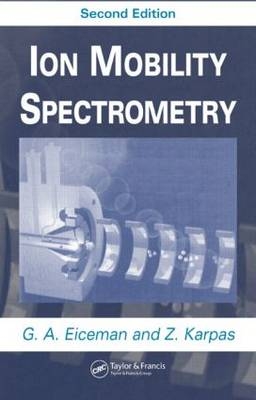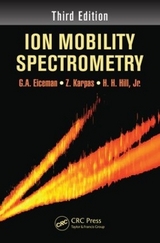
Ion Mobility Spectrometry, Second Edition
Crc Press Inc (Verlag)
978-0-8493-2247-1 (ISBN)
- Titel erscheint in neuer Auflage
- Artikel merken
Key Developments for Faster, More Precise Detection Capabilities
Driven by the demand for the rapid and advanced detection of explosives, chemical and biological warfare agents, and narcotics, ion mobility spectrometry (IMS) undergone significant refinements in technology, computational capabilities, and understanding of the principles of gas phase ion chemistry and mobility. Beginning with a thorough discussion of the fundamental theories and physics of ion mobility, Ion Mobility Spectrometry, Second Edition describes the recent advances in instrumentation and newly pioneered applications.
Divided into three sections, the first presents a history of technological developments, basic principles, theories, and other factors that govern the response in IMS. The second section describes aspects of IMS technology including sample introduction methods, draft tubes, modern methods for data analysis and display, the combination of mobility spectrometers with chromatographic methods, miniaturized IMS sensors, alternative ionization sources, and advances in computational capabilities that improved the acquisition and treatment of data. The final section emphasizes rapidly developing and exciting applications of IMS. The section is subdivided into existing, proven and potential applications encompassing the traditional forensic, military, and counter-terrorism applications and the now well-developed methods for detect biological agents and characterizing bio-molecules. It also highlights other applications found in clinical and environmental venues and await further development.
This new edition of Ion Mobility Spectrometry offers a lucid and complete analysis of the technological and contextual developments surrounding the chemistry, instrumentation and growing number of applications of IMS that incorporate and depend upon the latest innovations in the field.
PART I: HISTORY, THEORY, AND BASIC PRINCIPLES OF ION MOBILITY SPECTROMETRY
Introduction to Ion Mobility Spectrometry
Background
Studies of Ions in Gases at Atmospheric Pressure
Early Developments of IMS as an Analytical Method (1970 to 1990)
Modern Analytical IMS
Present and Future Trends in IMS
References
Mobility of Ions in the Gas Phase
Introduction
Motion of Slow Ions in Gases
Models for Ion–Neutral Interactions
Models and Experimental Evidence
Dependence of Mobility on Electric Field
References
Appendix A: Sensitivity of Calculated Mobilities toward the Choice of Parameters
Gas-Phase Ion Chemistry in Mobility Spectrometers
Introduction and General Considerations
Ion Chemistry at Ambient Pressure
Analytical Facets of Gas-Phase Ion Reactions
The Interpretation of Mobility Spectra
Summary
References
PART II: TECHNOLOGY OF ION MOBILITY SPECTROMETRY
Drift Tubes for Mobility Spectrometers
Introduction
Inlets and Introduction of Sample
Ion Sources
Drift Tubes
Selection of Materials
Summary
References
Hyphenated Methods with Mobility Spectrometers
Introduction to Hyphenated Ion Mobility Spectrometry (IMS) Methods
GC/IMS
LC/IMS
IMS/MS
Summary
References
PART III: APPLICATIONS OF ION MOBILITY SPECTROMETRY
Forensics, Military, Security, and Counterterrorism
Introduction
Chemical Weapons
Detection of Explosives by IMS
Drugs
Other Forensic Applications
Conclusions
References
Biologial, Biomolecular Research, and Medical Uses of IMS
Introduction
Medical Diagnostics Using IMS
Food Freshness and Odor Detection
Proteins, Peptides, Amino Acids, and Other Large Biomolecules and Biopolymers
Detection and Determination of Bacteria
Conclusion
References
Developed Applications in Industrial and Environmental Monitoring
Introduction
Acidic and Corrosive Gases
Volatile Organic Compounds and Halocarbons
Ammonia in Water, Air, Clean Rooms, and Process Streams
Gas Purity and Trap Efficiency
SF Purity in Electrical Switches
Semiconductor Manufacturing
Recirculated or Controlled Atmospheres
VOCs in the Air of the International Space Station
Conclusion
References
Feasible Applications
Introduction
Occupational Hygiene and Air Quality
Fugitive Emissions from Industrial Activity
Smoke Alarm with Identification of Combustion Sources
Surface Analysis and Adsorbed Layers
Metal and Inorganic Ions
Aerosols and Electric Mobility Analyzers
Summary
References
Present Conditions, Barriers to Advances, and Future Developments in Ion Mobility Spectrometry
State of the Science and Technology of Ion Mobility Spectrometry (IMS)
Barriers to Advances in Performance and Uses
Future for IMS
Final Thoughts
| Erscheint lt. Verlag | 23.6.2005 |
|---|---|
| Zusatzinfo | 30 Halftones, black and white; 24 Tables, black and white; 105 Illustrations, black and white |
| Verlagsort | Bosa Roca |
| Sprache | englisch |
| Maße | 156 x 234 mm |
| Gewicht | 680 g |
| Themenwelt | Naturwissenschaften ► Physik / Astronomie ► Atom- / Kern- / Molekularphysik |
| ISBN-10 | 0-8493-2247-2 / 0849322472 |
| ISBN-13 | 978-0-8493-2247-1 / 9780849322471 |
| Zustand | Neuware |
| Informationen gemäß Produktsicherheitsverordnung (GPSR) | |
| Haben Sie eine Frage zum Produkt? |
aus dem Bereich



